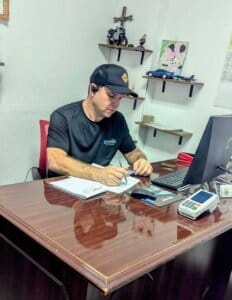Why Cooling System Winter Preparation is Critical in New Jersey
Winter in Newark, New Jersey, demands extra attention to your vehicle’s cooling system. While it might seem counterintuitive to worry about your cooling system when temperatures drop, neglecting this vital component can lead to catastrophic engine damage and leave you stranded in the middle of a snowstorm.
At EPR Auto Clinic, we see the consequences of inadequate cooling system winter preparation every season. The reality is that your cooling system works year-round, and winter conditions present unique challenges that can cause expensive damage if ignored.
Understanding the Winter Risks to Your Cooling System
The cooling system isn’t just about preventing overheating in summer. During winter, the primary threat is freezing. When water or improperly mixed coolant freezes, it expands with tremendous force – enough to crack your radiator, damage hoses, and even fracture the engine block itself.
The cost of neglect can be staggering:
- Cracked engine block repair: $3,000 – $5,000+
- Radiator replacement: $400 – $900
- Head gasket replacement: $1,500 – $3,000
Compare these costs to preventive maintenance, and the choice is clear. Proper cooling system winter preparation is one of the smartest investments you can make for your vehicle.
Essential Components of Your Cooling System
Before diving into winter preparation, let’s understand what makes up your cooling system:
The Radiator: The heart of the system, dissipating heat from the coolant Coolant/Antifreeze: The fluid that transfers heat and prevents freezing Water Pump: Circulates coolant throughout the engine Thermostat: Regulates coolant flow and engine temperature Hoses and Clamps: Connect all components and maintain system pressure Radiator Cap: Maintains proper system pressure Heater Core: Provides cabin heat using hot coolant
Each component plays a crucial role, and a failure in one can compromise the entire system.
Complete Cooling System Winter Preparation Checklist
1. Check and Replace Your Coolant (Antifreeze)
The most critical step in cooling system winter preparation is ensuring your coolant is at the proper concentration and condition.
What to Check:
- Coolant Level: Should be between the minimum and maximum marks on the reservoir
- Mixture Ratio: The ideal ratio is 50/50 antifreeze to distilled water, providing protection down to approximately -34°F
- Coolant Condition: Fresh coolant is bright in color (green, pink, orange, or yellow depending on type). If it looks rusty, murky, or has particles floating in it, it needs replacing
- Coolant Type: Always consult your owner’s manual. Different vehicles require specific types (OAT, HOAT, IAT). Mixing incompatible coolants can cause corrosion and system failure
DIY or Professional Service?
While checking coolant level is simple, testing concentration requires a special tool (refractometer or test strips). At EPR Auto Clinic, we include coolant testing in every winter inspection.
Approximate Cost:
Coolant top-off: $15 – $30
Complete coolant exchange: $100 – $150
Prices are estimates and may vary based on vehicle type and coolant capacity. Contact EPR for an accurate quote.
2. Inspect All Hoses and Connections
Radiator hoses endure extreme temperature swings and constant pressure. Winter’s harsh conditions accelerate deterioration.
What to Look For:
- Cracks or Splits: Even small cracks can burst under pressure
- Soft or Spongy Spots: Indicates internal deterioration
- Bulges or Swelling: Sign of imminent failure
- Hardness: Hoses should be flexible, not rigid
- Connection Points: Check for leaks at clamps and joints
- Age: Most hoses should be replaced every 4-5 years regardless of appearance
Warning Signs:
If you notice a sweet smell (like maple syrup) or see colored puddles under your car, you likely have a coolant leak. Address this immediately.
Approximate Cost:
Single radiator hose replacement: $75 – $150
Upper and lower hose replacement: $150 – $250
Prices are estimates and may vary by vehicle make and model.
3. Test the Radiator Cap
A faulty radiator cap is one of the most overlooked causes of cooling system problems. This small component maintains the proper pressure in your system (typically 13-16 PSI), which raises the boiling point of coolant and prevents evaporation.
Signs of a Bad Radiator Cap:
- Collapsed radiator hoses
- Coolant reservoir constantly overflowing
- Persistent overheating
- Visible corrosion on the cap
- Damaged or missing rubber seal
At EPR Auto Repair in Newark, we pressure-test radiator caps as part of our cooling system inspection. If the cap fails to hold pressure, it’s time for replacement.
Approximate Cost:
Radiator cap replacement: $15 – $35
Price estimate includes parts and installation.
4. Perform a Cooling System Flush
Over time, coolant breaks down and loses its protective properties. Old coolant becomes acidic, causing internal corrosion. Rust, scale, and sediment accumulate in the radiator and engine passages, reducing cooling efficiency.
Why a Flush is Essential:
- Removes rust, scale, and contaminants
- Restores optimal heat transfer
- Prevents corrosion
- Extends the life of water pump and thermostat
- Improves heater performance
The EPR Flush Process:
- Drain old coolant completely
- Use specialized cleaning solution to remove deposits
- Flush system with clean water
- Refill with proper coolant mixture
- Bleed air from system
- Pressure test for leaks
When to Flush:
Most manufacturers recommend flushing every 30,000-50,000 miles or every 2-5 years. However, if your coolant looks discolored or contaminated, don’t wait.
Approximate Cost:
Standard cooling system flush: $125 – $200
Heavy-duty flush (for neglected systems): $175 – $250
Estimates include labor, coolant, and disposal fees. Actual price may vary.
5. Inspect the Water Pump
The water pump circulates coolant throughout the engine. While it’s not always visible, certain symptoms indicate potential failure:
Warning Signs:
- Coolant leaking from the front of the engine
- Whining or grinding noise from the front of the engine
- Overheating
- Steam from the radiator
- Loose or wobbling pulley
Water pumps typically last 60,000-90,000 miles, but can fail prematurely, especially if coolant hasn’t been maintained properly.
Approximate Cost:
Water pump replacement: $300 – $750
Price varies significantly based on vehicle make, model, and engine type. Some vehicles require extensive labor due to pump location.
6. Check the Thermostat
The thermostat controls coolant flow based on engine temperature. A stuck-open thermostat causes the engine to run too cold, reducing efficiency and preventing proper cabin heating. A stuck-closed thermostat causes overheating.
Symptoms of Thermostat Problems:
- Engine takes forever to warm up
- Heater blows cold air
- Temperature gauge fluctuates wildly
- Engine overheats quickly
Approximate Cost:
Thermostat replacement: $150 – $300
Estimate includes parts and labor.
7. Test Cabin Heater Performance
Your heater core is part of the cooling system, using hot coolant to warm the cabin. Poor heater performance often indicates cooling system issues.
What to Check:
- Does the heater blow hot air quickly?
- Is airflow strong and consistent?
- Any sweet smell from the vents? (indicates leaking heater core)
- Foggy windows that won’t clear? (possible heater core leak)
A leaking heater core can dump coolant into your cabin, creating a sticky mess and potentially dangerous situation.
Approximate Cost:
Heater core replacement: $500 – $1,200
Labor-intensive job; price varies greatly by vehicle accessibility.
Additional Winter Cooling System Tips from EPR
Use the Right Coolant
Never use plain water, even in emergencies. Water freezes at 32°F and causes corrosion. Always use a proper antifreeze mixture.
Coolant Types:
- Green (IAT): Traditional formula, typically for older vehicles
- Orange (OAT): Extended life, common in GM vehicles
- Pink/Red (HOAT): European and Asian vehicles
- Yellow (HOAT): Ford and Chrysler vehicles
Using the wrong type can cause chemical reactions that damage gaskets and seals.
Monitor Your Temperature Gauge
Modern cars have sophisticated cooling systems, but the temperature gauge is your first warning of problems. If the gauge rises above normal operating temperature, pull over safely and investigate immediately.
Keep Your Radiator Exterior Clean
Road salt, dirt, and debris can clog the radiator fins, reducing cooling efficiency. A professional cleaning during your cooling system winter preparation service helps maintain optimal performance.
Don’t Ignore Warning Lights
If your check engine light or temperature warning light illuminates, don’t delay. Modern sensors can detect problems before they become catastrophic.
Why Choose EPR Auto Clinic for Cooling System Winter Preparation in Newark?
At EPR Auto Clinic, we understand the unique challenges Newark drivers face during harsh New Jersey winters. Our comprehensive cooling system winter preparation service includes:
✓ Complete visual inspection of all cooling system components
✓ Coolant concentration testing with professional equipment
✓ Pressure testing to identify leaks
✓ Computer diagnostics for temperature sensors and thermostat function
✓ Detailed report of findings with photo documentation
✓ Honest recommendations – we only suggest necessary repairs
✓ Quality parts backed by warranty
✓ Experienced technicians who specialize in all makes and models
Don’t Wait Until It’s Too Late
The middle of a snowstorm is the worst time to discover your cooling system isn’t ready for winter. Many cooling system failures happen when you start your car on the coldest morning of the year, don’t let that be your story.
Schedule Your Cooling System Winter Preparation Service Today!
Protect your engine, avoid costly repairs, and drive with confidence this winter. Our team at EPR Auto Clinic is ready to ensure your vehicle’s cooling system is properly prepared for everything a Newark winter can throw at it.
Contact EPR Auto Clinic:
📍 Newark, NJ
Special Note: Cooling system services typically take 1-2 hours. We recommend scheduling an appointment to minimize your wait time, especially during the busy pre-winter season.





